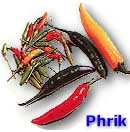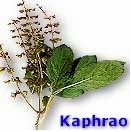| |
|
|
|
|
|
Thai cuisine is surely one of mankind's most delicious and exciting culinary art forms.Once almost unknown outside Thailand, the delights of Thai cuisine are now to be found in countless restaurants around the world, but they are best
enjoyed, of course, in their country of origin
exciting culinary art forms.Once almost unknown outside Thailand, the delights of Thai cuisine are now to be found in countless restaurants around the world, but they are best
enjoyed, of course, in their country of origin |
|
 |
|
|
Although it draws heavily on several of the great Asian culinary traditions, particularly Indian and Chinese, Thai food is unique, for its subtle combination of myriad
ingredients, spices, herbs and sauces.The tastes of Thailand range from hot curries to mildly aromatic desserts and can sometimes surprise the visitor, for instance in the combination of both
sweet and salty elements in the same dish.The huge variety of natural ingredients used, and the complexity of recipes will certainly be one of the greatest treats in store for lovers of fine
food when visiting Thailand.One popular misconception about Thai cuisine is that it is invariably hot -'chili hot', that is. In fact, many dishes are no hotter or spicier than any other Asian
style. Chili is often an optional ingredient, which diners add to their taste.What makes Thai food so appealingly different is the inclusion of many kinds of exotic and aromatic herbs and
spices, not necessarily hot. Of these, garlic-Thai garlic is slightly less pungent than its European counterpart - pepper, coriander and liberal doses of nam pla, a fermented fish sauce, are the most
commonly used.Like other Asian nations, Thailand has rice as its staple. The long grain variety is the most popular and is usually cooked by steaming, without the use of additives. The result
is that it is light and fluffy and so fragrant that it can be eaten by itself. Another variety of Thai rice is more glutinous, a sticky texture that is especially popular in the North.
Noodles of various kinds can also form the basis of a meal or used in dishes such as pad Thai, fried noodles with baby shrimp and bean curd.To the basic rice and
noodles are added various other dishes. In Thai cooking, frying, boiling, steaming, barbecuing and baking are main methods employed.A combination of herbs and spices, freshly ground, can either
be put directly into the pan for frying with the main ingredients or added to soups and stewed dishes. Alternatively, a paste featuring chili, lemon grass, coriander root, garlic, shrimp curd and pepper is
used.A typical family dinner may well have fish, pork and chicken on the same menu. All dishes including soup are served at the same time, the soup being in individual bowls and the main dishes
being communal, with diners taking only spoonfuls of each at a time and mixing it with the rice on their plates. A spoon and fork are the usual eating utensils, with chopsticks being used by ethnic Chinese.The menu at a typical Thai restaurant will be amazingly long and will be a testament to the cook's creative imagination. The various dishes on offer can be broken down into seven main categories: soups, poultry, meats, seafood, rice and noodles, vegetables and
salads, and desserts.

Thai soups can feature virtually any kind of ingredient, from mushrooms and pumpkin to shrimp and catfish, or any type of meat. Some are flavored
with coconut milk, while others are based on fish or meat stock. Probably Thailand's most famous soup is tom yum gung, a hot and soup prawn mixture with a tongue-tingling taste achieved by mixing the flavors
of chili, lemon grass and fresh limejuice.

These are rarely simply boiled in the western way. Rather, they are stir-fried with garlic and oyster sauce, or steamed, in which case they are
often eaten with small fried fish and a pungent shrimp sauce, Salads, too, hardly resemble their western counterparts. A typical salad might include beef and chili, plus strips of lettuce and tomato, or
green mango, As an alternative, there is a green papaya salad, known as som tum, which also features ginger, lime juice, fish sauce, chopped dried shrimps and peanuts.

Thailand produces excellent poultry, including chicken, duck and pigeon. These may be cooked in many ways, wrapped in pandanus leaves,
made into a curry, barbecued, casseroled, or stuffed with tomatoes, onions, or even ground pork. Meats are invariably cut into small pieces, which are then cooked in various ways. Among the favorite methods
of preparation are fried with garlic and Thai pepper, or as part of a curry, particularly gaeng keowan, green curry. Thailand's seas and inland waterways provide a huge selection of fresh and dried seafood.
These include lobsters and crayfish, prawn, crab, mussels, clams and an almost endless variety of fish. The cooking methods for these vary from steaming to frying, or as part of a soup. Fish is often served
with a thick or spicy sauce and sprinkled with crispy fried garlic. Certainly worth trying are gaeng garee gung, lobster and prawn curry; poo pad pong garee, curry powder and chilli crab; tort mun pla, fried
fish cakes and plakapong-kow nuang, steamed sea bass.

To round off a great meal, Thailand offers some really delicious desserts. Often made from rice, tapioca or types of jelly, these are mixed with
fruit, fresh or preserved, and chipped ice. They provide the perfect complement to a rich and spicy meal. Not to be missed are sankaya gap kanoon, coconut custard with jackfruit pieces, kow-neeo ma-muang
sticky rice with mango and eye-teem kati, coconut ice cream. Finally, a word about Thai fruits: These
are abundant in number and variety, but among the best are pineapple, banana, orange, pomelo, mangosteen, rambutan and lychee. these are mixed with
fruit, fresh or preserved, and chipped ice. They provide the perfect complement to a rich and spicy meal. Not to be missed are sankaya gap kanoon, coconut custard with jackfruit pieces, kow-neeo ma-muang
sticky rice with mango and eye-teem kati, coconut ice cream. Finally, a word about Thai fruits: These
are abundant in number and variety, but among the best are pineapple, banana, orange, pomelo, mangosteen, rambutan and lychee.
|
|